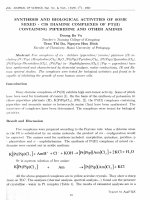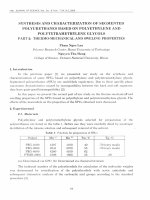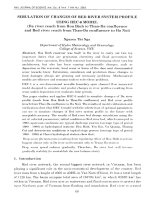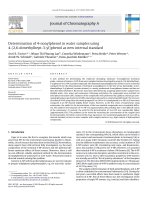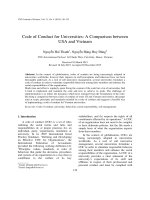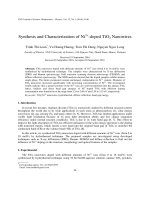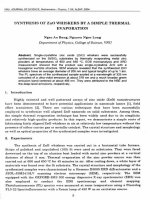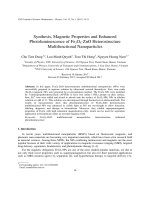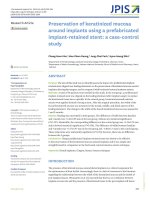DSpace at VNU: Synthesis of novel 2-aryl-3-benzoy1-1H-benzo[f]indole-4,9-diones using a domino reaction
Bạn đang xem bản rút gọn của tài liệu. Xem và tải ngay bản đầy đủ của tài liệu tại đây (569.88 KB, 9 trang )
Accepted Manuscript
Synthesis of novel 2-aryl-3-benzoyl-1H-benzo[f]indole-4,9-diones using a
domino reaction
Trung Quang Nguyen, Thuy Giang Le Nhat, Doan Vu Ngoc, Tuyet Anh Dang
Thi, Ha Thanh Nguyen, Phuong Hoang Thi, Hung Huy Nguyen, Hai Thuong
Cao, Kourosch Abbaspour Tehrani, Tuyen Van Nguyen
PII:
DOI:
Reference:
S0040-4039(16)31041-3
/>TETL 48013
To appear in:
Tetrahedron Letters
Received Date:
Revised Date:
Accepted Date:
7 July 2016
12 August 2016
15 August 2016
Please cite this article as: Nguyen, T.Q., Le Nhat, T.G., Vu Ngoc, D., Dang Thi, T.A., Nguyen, H.T., Hoang Thi,
P., Nguyen, H.H., Cao, H.T., Tehrani, K.A., Nguyen, T.V., Synthesis of novel 2-aryl-3-benzoyl-1Hbenzo[f]indole-4,9-diones using a domino reaction, Tetrahedron Letters (2016), doi: />j.tetlet.2016.08.042
This is a PDF file of an unedited manuscript that has been accepted for publication. As a service to our customers
we are providing this early version of the manuscript. The manuscript will undergo copyediting, typesetting, and
review of the resulting proof before it is published in its final form. Please note that during the production process
errors may be discovered which could affect the content, and all legal disclaimers that apply to the journal pertain.
Synthesis of novel 2-aryl-3-benzoyl-1H-benzo[f]indole-4,9-diones using a domino
reaction
Trung Quang Nguyena, Thuy Giang Le Nhata, Doan Vu Ngoca,b, Tuyet Anh Dang Thia, Ha Thanh
Nguyena, Phuong Hoang Thia, Hung Huy Nguyenc, Hai Thuong Caob, Kourosch Abbaspour Tehranid,
Tuyen Van Nguyena,*
a
Institute of Chemistry, Vietnam Academy of Science and Technology, 18-Hoang Quoc Viet, Cau Giay, Hanoi, Vietnam
Le Quy Don Technical University, 236-Hoang Quoc Viet, Cau Giay, Hanoi, Vietnam
c
Hanoi University of Science, 19-Le Thanh Tong, Hoan Kiem, Hanoi, Vietnam
d
Organic Synthesis, Faculty of Sciences, University of Antwerp, Groenenborgerlaan 171, B-2020 Antwerp, Belgium
b
* Corresponding author. Tel.: +84 917683979. E-mail address: (T. Van Nguyen)
ABSTRACT
A convenient one-pot multicomponent synthetic approach was developed for the
synthesis of novel 2-aryl-3-benzoyl-1H-benzo[f]indole-4,9-diones using 2-amino-1,4naphthoquinone, N-acylmethylpyridinium bromides and a variety of aromatic aldehydes.
Keywords: Benzo[f]indole-4,9-dione, domino reactions, 2-amino-1,4-naphthoquinone
Quinone moieties, especially nitrogen heterocyclic quinones, are important structural
units in many natural and unnatural products that possess a wide range of biological
activities.1 Naturally occurring quinones are found in bacteria, fungi and plants, for example;
benz[g]isoquinoline-5,10-dione 1 (Fig. 1), isolated from Psychotria camponutans and
Mitracarpus scaber, exhibit antimalarial and trypanocidal activities as well as growth
inhibition against multi-drug resistant pathogens.2 2-Azaanthraquinone 1 and its oxygenated
derivatives 2-5 interfere with the activity of DNA topoisomerases and have attracted
considerable attention in cancer chemotherapy as intercalating DNA binding agents.3
Moreover, bostrycoidin 2 and 9-O-methylbostrycoidin 3 show antibiotic activity against the
tubercle bacil and G+ bacteria, respectively,4 whilst tolypocladin 4 displays metal-chelating
properties.5 In conjunction with the azaanthraquinones, p-indolequinones are important
nitrogen heterocyclic quinones, which possess interesting bioactivities such as anticancer
activitity6 as well as the ability to trigger drug release.7 Examples include 3ethoxycarbonylbenzoindole-4,9-diones 6-8, which exhibit greater cytotoxic activity against a
wide variety of human tumor cell lines than etoposide and doxorubicin.1e,1f,8,9 Compound 8
(SME-6) induces G2/M cell cycle arrest and apoptosis in cultured human lung cancer cells
and results in the inhibition of not only invasion or metastasis-associated protease activities,
but also degradation and cellular invasion of the extracellular matrix and basement
membrane.1e,1f Recently, 3-methyl-1H-benzo[f]indole-4,9-dione 910 and 2-methyl-8-hydroxy1H-benzo[f]indole-4,9-dione 10 (Utahmycin B),11 isolated from Goniothalamus tapis Miq
and Streptomyces albus, respectively, were found to be promising bioactive compounds.
Due to the broad biological relevance of p-indoloquinones, in particular benzo[f]indole4,9-diones, possessing antineoplastic, antibacterial, virustatic, fungicidal, anti-inflammatory
and anticoagulant properties,1e-g,8,10-12 considerable effort has been devoted to the
development of new syntheses of this class of compounds. Reported methods are mostly
based on metal-initiated oxidative-free radical reactions between 2-amino-1,4naphthoquinones and β-dicarbonyl or carbonyl compounds,13 the Diels-Alder reaction of
indole-4,7-dione with conjugated dienes,14 the multicomponent reaction of 2-bromo-1,4naphthoquinone, primary amines and β-dicarbonyl compounds,15 the transition metalcatalyzed reaction of 1,4-naphthoquinone derivatives1k,16 and the one-pot sequential C,Ndialkylation of enaminones using 2,3-dichloronaphthoquinone.17
Figure 1. Chemical structures of several biologically active heterocyclic naphthoquinones
In a continuation of our interest in the synthesis of heterocyclic naphthoquinones18 and
domino reactions,18j,k herein, we report the synthesis of novel 2-aryl-3-benzoyl-1Hbenzo[f]indole-4,9-diones from 2-aminonaphthalene-1,4-dione using a one-pot,
multicomponent domino reaction (MDR). Multicomponent domino reactions have been
widely applied in recent years as they provide high structural diversity through multiple
bond-forming reactions in a one-pot approach with high synthetic efficiency.19 These
reactions involve at least three substrates and produce two or more bond-forming
transformations, based on functionalities induced in the previous step, without changing the
reaction conditions or adding catalysts and/or additional reagents.19a,20 Furthermore,
structure-activity relationships concerning functionalized heterocyclic naphthoquinones have
shown that the introduction of chemically diverse side chains to the heterocyclic ring can
enhance the bioactivities of these molecules,21 making the synthesis of new heterocyclic
naphthoquinones through MDR an appropriate challenge.
The synthesis of the target naphthoquinones 14a-n was conducted using a one-pot
MDR, starting from simple and readily available substrates, namely 2-amino-1,4naphthoquinone 11, N-acylmethylpyridinium bromides 1218b,i,j,22 and aromatic aldehydes 13.
N-Acylmethylpyridinium bromides were obtained in 90-95% yield via the reaction of
pyridine (1 equiv.) and 2-bromomethylacetophenone derivatives (1 equiv.) in acetonitrile at
room temperature for 12 h. Thus, a solution of 2-amino-1,4-naphthoquinone 11 (1 equiv.),
pyridinium bromide 12 (1.2 equiv.) and triethylamine (5 equiv.) in toluene was heated at
reflux for 30-60 min, after which aromatic aldehyde 13 (1.2 equiv.) was added. The resulting
mixture was further heated at reflux for 24 h. Using this reaction 14 new fused
benzo[f]indole-4,9-diones 14a-n were obtained in 45-65% yield after purification by silica
gel column chromatography (Scheme 1, Table 1).23 The proposed molecular structures of the
functionalized naphthoquinones 14a-n were assigned by 1H NMR, 13C NMR, MS and IR
analysis. Single crystal X-Ray analysis was performed on compound 14k to confirm the
structure of this molecular framework (Fig. 2). Both electron-donating and electronwithdrawing substituents on the phenyl moieties were selected to assess their influence on the
reaction outcome. However, no major effect was observed, leading to comparable yields in
all cases.
Scheme 1. Synthesis of 2-aryl-3-benzoyl-1H-benzo[f]indole-4,9-diones 14a-n
Table 1. Synthesis of 2-aryl-3-benzoyl-1H-benzo[f]indole-4,9-diones 14a-n
Entry
1
2
3
4
5
6
7
8
9
10
11
12
13
14
R1
C6H5
C6H5
C6H5
C6H5
C6H5
C6H5
C6H5
C6H5
C6H5
C6H5
4-FC6H4
4-FC6H4
3-HOC6H4
3-HOC6H4
R2
C6H5
3-MeOC6H4
4-MeOC6H4
3-MeO-4-HOC6H3
3-BrC6H4
4-BrC6H4
4-ClC6H4
4-Me2NC6H4
naphth-2-yl
3,4-methylenedioxyphenyl
C6H5
naphth-2-yl
C6H5
4-MeOC6H4
Compound
14a
14b
14c
14d
14e
14f
14g
14h
14i
14j
14k
14l
14m
14n
Yield (%)
63
59
60
62
48
47
45
45
48
47
65
40
47
45
Figure 2. Single crystal X-ray structure of compound 14k
A possible mechanistic interpretation of this MDR begins with the Michael addition of
2-amino-1,4-naphthoquinone 11 with N-acylmethylpyridinium ylides 15, formed in situ by
the deprotonation of pyridinium bromides 12 by Et3N.18a,b,e After the elimination of pyridine
from intermediates 16, compounds 18 engage in a base promoted Knoevenagel condensation
with aromatic aldehydes 13, resulting in the formation of naphthoquinones 22. The latter
undergo intramolecular nucleophilic attack of the vinyligous amide nitrogen atom to produce
compounds 24, which undergo keto-enol tautomerization and auto-oxidation to furnish the
desired substituted 1H-benzo[f]indole-4,9-diones 14 (Scheme 2). The reaction could also
proceed via a Mannich type reaction, in which the condensation of compound 19 with
aromatic aldehydes leads to a Schiff base which after a subsequent cyclization sequence
provides compound 24.
In conclusion, the efficient synthesis of novel 2-aryl-3-benzoyl-1H-benzo[f]indole-4,9quinones 14 using a one-pot MDR from 2-amino-1,4-naphthoquinone, pyridinium bromides
and aromatic aldehydes has been described. The influence of electron-donating and electronwithdrawing substituents on the phenyl moieties on the reaction outcome was also evaluated.
These heterocyclic naphthoquinones could represent interesting new structures for the pursuit
of biologically active compounds.
O
O
R1
H2N
Et3N
N
Br
R
N
11
O
NH2
OH
15
OH
17
O
R1
O
R1
O
NH2
16
O
N
OH
R1
O
- Et3HNBr
12
N
O
O
1
OH
R2 H
13
O
R1
O
O
NH2
2
R
NH2
R1
Aldol pathway
O
R1
O
NH2
Et3N
O
NH2
O
O
O
OH
21
20
19
18
R2CHO
- H2O
Mannich pathway
O
O
1
R
O
O
R1
O
O
R1
O
O
R1
2
R
Michael addition
R2
NH2
O
O
22
R2
N
H2
O
23
N
H
OH
25
24
O
O
R1
R2
O
14
R2
OH
N
H
O
auto-oxidation
N
H
R1
R2
OH
26
N
H
Scheme 2. Proposed mechanism for the formation of compounds 14
Acknowledgements
The authors are indebted to the Bilateral Scientific Research Cooperation Projects
between FWO (Flanders, G005514N) and NAFOSTED (Vietnam, FWO.104.2013.12) for
financial support.
References and notes
1. (a) Thomson, R. H. Naturally Occurring Quinones, 2nd ed.; Academic Press: London and New York, 1971;
(b) Thomson, R. H. Naturally Occurring Quinones III: Recent Advances, 3rd ed.; Chapman and Hall: London
and New York, 1987; (c) Sharma, P. S.; Pietrzyk-Le, A.; D’Souza, F.; Kutner, W. Anal. Bioanal. Chem. 2012,
402, 3177-3204; (d) Furstner, A. Angew. Chem. Int. Ed. 2003, 42, 3582-3603; (e) Lee, E.-J.; Lee, H.-J.; Park, H.
J.; Min, H.-Y.; Suh, M.-E.; Chung, H.-J.; Lee, S. K. Bioorg. Med. Chem. Lett. 2004, 14, 5175-5178; (f) Park, H.
J.; Lee, H.-J.; Min, H.-Y.; Chung, H.-J.; Suh, M. S.; Park-Choo, H.-Y.; Kim, C.; Kim, H. J.; Seo, E.-K.; Lee, S.
K. Eur. J. Pharmacology 2005, 527, 31-36; (g) Ryu, C.-K.; Lee, J. Y.; Jeong, S. H.; Nho, J.-H. Bioorg. Med.
Chem. Lett. 2009, 19, 146-148; (h) Ryu, C.-K.; Yoon, J. H.; Song, A. L.; Im, H. A.; Kim, J. Y.; Kim, A. Bioorg.
Med. Chem. Lett. 2012, 22, 497-499; (i) Shchekotikhin, A. E.; Glazunova, V. A.; Dezhenkova, L. G.; Kaluzhny,
D. N.; Luzikov, Y. N.; Buyanov, V. N.; Treshalina, H. M.; Lesnaya, N. A.; Romanenko, V. I.; Balzarini, J.;
Agama, K.; Pommier, Y.; Shtil, A. A.; Preobrazhenskaya, M. N. Eur. J. Med. Chem. 2014, 86, 797-805; (j)
Nadji-Boukrouche, A. R.; On, S.; Khoumeri, O.; Terme, T.; Vanelle, P. Tetrahedron Lett. 2015, 56, 2272-2275;
(k) Guo, S.; Chen, B.; Guo, X.; Zhang, G.; Yu, Y. Tetrahedron 2015, 71, 9371-9375; (l) Gach, K.; Modranka,
J.; Szymanski, J.; Pomorska, D.; Krajewska, U.; Mirowski, M.; Janecki, T.; Janecka, A. Eur. J. Med. Chem.
2016, 120, 51-63; (m) Luu, Q. H.; Guerra, J. D.; Castaneda, C. M.; Martinez, M. A.; Saunders, J.; Garcia, B. A.;
Gonzales, B. V.; Aidunithula, A. R.; Mito, S. Tetrahedron Lett. 2016, 57, 2253-2256.
2. (a) Krapcho, A. P.; Waterhouse, D. J. Heterocycles 1999, 51, 737-749. (b) Okunade, A. L.; Clark, A. M.;
Hufford, C. D.; Oguntimein, B. O. Planta Med. 1999, 65, 447-448. (c) Nok, A. J. Cell Biochem. Funct. 2002,
20, 205-212. (d) Chem. Abstr. Nr. 2002, 636119.
3. Khanapure, S. P.; Biehl, E. R. Heterocycles 1988, 27, 2643-2650.
4. (a) Arsenault, G. P. Tetrahedron Lett. 1965, 45, 4033-4037; (b) Steyn, P. S.; Wessels, P. L.; Marasas, W. O.
F. Tetrahedron 1979, 35, 1551-1555.
5. Grafe, U.; Ihn, W.; Tresselt, D.; Miosga, N.; Kaden, U.; Schlegel, B.; Bormann, E.-J.; Sedmera, P.; Novak, J.
Biol. Metals 1990, 3, 39-44.
6. (a) Martin, T.; Moody, C. J. J. Chem. Soc., Perkin Trans. 1 1988, 235-240; (b) Matsuo, K.; Ishida, S. Chem.
Express 1993, 8, 321-324; (c) Moody, C. J.; Swann, E. Tetrahedron Lett. 1993, 34, 1987-1988; (d) Matsuo, K.;
Ishida, S. Chem. Pharm. Bull. 1994, 42, 1325-1327; (e) Hagiwara, H.; Choshi, T.; Fujimoto, H.; Sugino, E.;
Hibino, S. Chem. Pharm. Bull. 1998, 46, 1948-1949; (f) Hagiwara, H.; Choshi, T.; Nobuhiro, J.; Fujimoto, H.;
Hibino, S. Chem. Pharm. Bull. 2001, 49, 881-886; (g) Sofiyev, V.; Lumb, J.-P.; Volgraf, M.; Trauner, D. Chem.
Eur. J. 2012, 18, 4999-5005; (h) Wang, C.; Sperry, J. Tetrahedron 2013, 69, 4563-4577.
7. (a) Huang, B.; Desai, A.; Tang, S.; Thomas, T. P.; Baker, J. R. Org. Lett. 2010, 12, 1384-1387; (b) Ferrer, S.;
Naughton, D. P.; Threadgill, M. D. Tetrahedron 2003, 59, 3445-3454; (c) Sharma, K.; Iyer, A.; Sengupta, K.;
Chakrapani, H. Org. Lett. 2013, 15, 2636-2639; (d) Schäfer, A.; Burstein, E. S.; Olsson, R. Bioorg. Med. Chem.
Lett. 2014, 24, 1944-1947; (e) Skibo, E. B.; Xing, C.; Dorr, R. T. J. Med. Chem. 2001, 44, 3545-3562.
8. Lee, H. J.; Suh, M. E.; Lee, Ch.O. Bioorg. Med. Chem. 2003, 11, 1511-1519.
9. Park, H. J.; Lee, H.-J.; Lee, E.-J.; Hwang, H. J.; Shin, S.-H.; Shu, M.-E.; Kim, Ch.; Kim, H. J.; Seo, E.-K.;
Lee, S. K. Biosci. Biotechnol. Biochem. 2003, 67, 1944-1949.
10. Efdi, M.; Fujita, S.; Inuzuka, T.; Koketsu, M. Nat. Prod. Res. 2010, 24, 657-662.
11. Bauer, J. D.; King, R. W.; Brady, S. F. J. Nat. Prod. 2010, 73, 976-979.
12. Moharam, B. A.; Jantan, I.; Jalil, J.; Ahmad, F. Phytother Res. 2012, 26, 687-691.
13. (a) Jiang, M. C.; Chuang, C. P. J. Org. Chem. 2000, 65, 5409-5412; (b) Wu, Y. L.; Chuang, C. P.
Tetrahedron 2002, 57, 5543-5549; (c) Tseng, C. C.; Wu, Y. L.; Chuang, C. P. Tetrahedron 2004, 60, 1224912260.
14. (a) Weeratunga, G.; Prasad, G. K. B.; Dilley, J.; Taylor, N. J.; Dmitrienko, G. I. Tetrahedron Lett. 1990, 31,
5713-5716; (b) Mithani, S.; Weeratunga, G.; Taylor, N. J.; Dmitrienko, G. I. J. Am. Soc. Chem. 1994, 116,
2209-2210.
15. Suryavanshi, P. A.; Sridharan, V.; Menendez, J. C. Org. Biomol. Chem. 2010, 8, 3426-3436.
16. (a) Inman, M.; Moody, C. J. J. Org. Chem. 2010, 75, 6023-6026; (b) Inman, M.; Moody, C. J. Eur. J. Org.
Chem. 2013, 2179-2187; (c) Shvartberg, M. S.; Kolodina, E. A.; Lebedeva, N. I.; Fedenok, L. G. Tetrahedron
Lett. 2009, 50, 6769-6771; (d) Yamashita, M.; Ueda, K.; Sakaguchi, K.; Iida, A. Tetrahedron Lett. 2011, 52,
4665-4670.
17. Hu, H.-Y.; Liu, Y.; Ye, M.; Xu, J.-H. Syntlett. 2006, 12, 1913-1917.
18. (a) Kesteleyn, B.; Tuyen Nguyen Van, T.; De Kimpe, N. Tetrahedron 1999, 55, 2091-2102; (b) Van
Nguyen, T.; Kesteleyn, B.; De Kimpe, N. Tetrahedron 2001, 57, 4213-4219; (c) Van Nguyen, T.; De Kimpe, N.
Tetrahedron 2003, 59, 5941-5946; (d) Van Nguyen, T.; De Kimpe, N. Tetrahedron Lett. 2004, 45, 3443-3446;
(e) Van Nguyen, T.; Verniest, G.; Claessens, S.; De Kimpe, N. Tetrahedron 2005, 61, 2295-2300; (f) Claessens,
S.; Verniest, G.; El Hady, S.; Van Nguyen, T.; Kesteleyn, B.; Van Puyvelde, L.; De Kimpe, N. Tetrahedron
2006, 62, 5152-5158; (g) Van Nguyen, T.; Claessens, S.; Habonimana, P.; Abbaspour Tehrani, K.; Van
Puyvelde, L.; De Kimpe, N. Synlett. 2006, 2469-2471; (h) Claessens, S.; Verniest, G.; Jacobs, J.; Van Hende, E.;
Habonimana, P.; Van Nguyen, T.; Van Puyvelde, L.; De Kimpe, N. Synlett. 2007, 829-850; (i) Dang Thi, T. A.;
Vu Thi, T. H.; Hoang Thi, P.; Nguyen, T. H.; Pham The, C.; Vu Duc. C.; Depetter, Y.; Van Nguyen, T.;
D’hooghe, M. Bioorg. Med. Chem. Lett. 2015, 25, 3355-3358; (j) Dang Thi, T. A.; Depetter, Y.; Mollet, K.;
Phuong, H. T.; Vu Ngoc, D.; Pham The, C.; Nguyen, H. T.; Nguyen Thi, T. H.; Nguyen, H. H.; D’hooghe, M.;
Van Nguyen, T. Tetrahedron Lett. 2015, 56, 2422-2425; (k) Dang Thi, T. A.; Depetter, Y.; Phuong, H. T.; Vu
Ngoc, D.; Nguyen, T. T.; Do Huy, T.; Nguyen, H. H.; D’hooghe, M.; Van Nguyen, T. Tetrahedron Lett. 2015,
56, 5855-5858.
19. (a) Brauch, S.; van Berkel, S. S.; Westermann, B. Chem. Soc. Rev. 2013, 42, 4948-4962; (b) Ramachary, D.
B.; Jain, S. Org. Biomol. Chem. 2011, 9, 1277-1300; (c) Rossi, B.; Pastori, N.; Prosperini, S.; Punta, C. Beilstein
J. Org. Chem. 2015, 11, 66-73.
20. (a) Tietze, L. F. Chem. Rev. 1996, 96, 115-136; (b) Pellissier, H. Chem. Rev. 2013, 113, 442-524.
21. (a) Perez-Sacau, E.; Estévez-Braun, A.; Ravelo, A. G.; Ferro, E. A.; Tokuda, H.; Mukainaka, T.; Nishino, H.
Bioorg. Med. Chem. 2003, 11, 483-488; (b) De Castro, S. L.; Emery, F. S.; Da Silva, E. N., Junior Eur. J. Med.
Chem. 2013, 69, 678-700.
22. (a) Aldersley, M. F.; Dean, F. M.; Hamzah, A. S. Tetrahedron Lett. 1986, 27, 255-258; (b) Aldersley, M. F.;
Chishti, S. H.; Dean, F. M.; Douglas, M. E.; Ennis, D. S. J. Chem. Soc., Perkin Trans. 1 1990, 2163-2174.
23. General procedure for the synthesis of 2-aryl-3-benzoyl-1H-benzo[f]indole-4,9-diones 14a-n: A solution of
2-amino-1,4-naphthoquinone 11 (1 equiv.), pyridinium bromide 12 (1.2 equiv.) and Et3N (5 equiv.) in toluene (5
ml) was heated at reflux for 30-60 min. Aromatic aldehyde 13 (1.2 equiv.) was added and the resulting mixture
was further heated at reflux for 24 h. The reation mixture was extracted with EtOAc (20 ml x 3) and the
combined organic phases dried with MgSO4 and evaporated in vacuo. The reaction mixture was purified by
column chromatography on silica gel using n-hexane/ethyl acetate (8:2). 3-(4-Fluorobenzoyl)-2-phenyl-1Hbenzo[f]indole-4,9-dione 14k: Orange yellow solid. Yield: 65%. Mp 286-287 oC. IR (KBr) cm-1: 3219, 1661,
1641, 1594, 1435, 1233, 1146, 967, 904, 766, 708, 685, 615, 510, 441; 1H NMR (CDCl3, 500 MHz): δ = 10.56
(s, 1H, NH), 8.15-8.13 (m, 1H), 8.07-8.05 (m, 1H), 7.98-7.96 (m, 2H), 7.70-7.68 (m, 2H), 7.56-7.54 (m, 2H),
7.39-7.37 (m, 3H), 7.08 (t, J = 7.5 Hz, 2H); 13C NMR (CDCl3, 125 MHz): δ = 191.52, 179.71, 176.12, 166.06
(d, J = 253.7 Hz, CF), 139.47, 134.15, 134.12, 133.93, 133.26, 133.00, 132.21, 132.13, 131.89, 129.63, 129.18,
129.06 (2xCH), 127.72 (2xCH), 127.25, 127.21, 126.48, 120.84, 115.90, 115.72; HRMS (ESI): m/z [M-H]calcd C25H13FNO3: 394.0879; found: 394.0876. Single crystal X-ray structure of compound 14k has been
deposited at the Cambridge Crystallographic Data Center with the following deposition number CCDC
1491059.
GRAPHICAL ABSTRACT
Synthesis of novel 2-aryl-3-benzoyl-1H-benzo[f]indole-4,9-diones using a domino reaction
Synthesis of novel 2-aryl-3-benzoyl-1H-benzo[f]indole-4,9-diones using a domino reaction
Trung Quang Nguyena, Thuy Giang Le Nhata, Doan Vu Ngoca,b, Tuyet Anh Dang Thia, Ha Thanh
Nguyena, Phuong Hoang Thia, Hung Huy Nguyenc, Hai Thuong Caob, Kourosch Abbaspour Tehranid,
Tuyen Van Nguyena,*
a
Institute of Chemistry, Vietnam Academy of Science and Technology, 18-Hoang Quoc Viet, Cau Giay, Hanoi,
Vietnam
b
Le Quy Don Technical University, 236-Hoang Quoc Viet, Cau Giay, Hanoi, Vietnam
c
Hanoi University of Science, 19-Le Thanh Tong, Hoan Kiem, Hanoi, Vietnam
d
Organic Synthesis, Faculty of Sciences, University of Antwerp, Groenenborgerlaan 171, B-2020 Antwerp, Belgium
* Corresponding author. Tel.: +84 917683979.
E-mail address: (T. Van Nguyen)
One-pot
multicomponent
synthesis
of
2-aryl-3-benzoyl-1H-benzo[f]indole-4,9-
quinones.
A mechanism for the transformation has been proposed.
Single crystal X-ray structure of 2-phenyl-3-(4-fluorobenzoyl)-1H-benzo[f]indole-4,9-
dione is provided.

